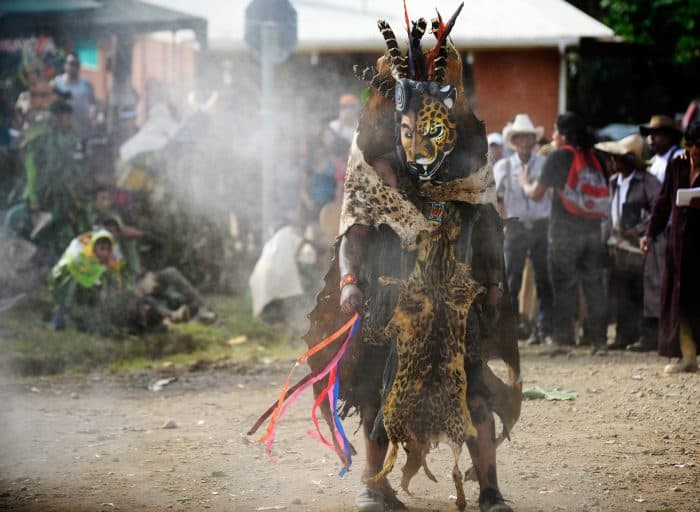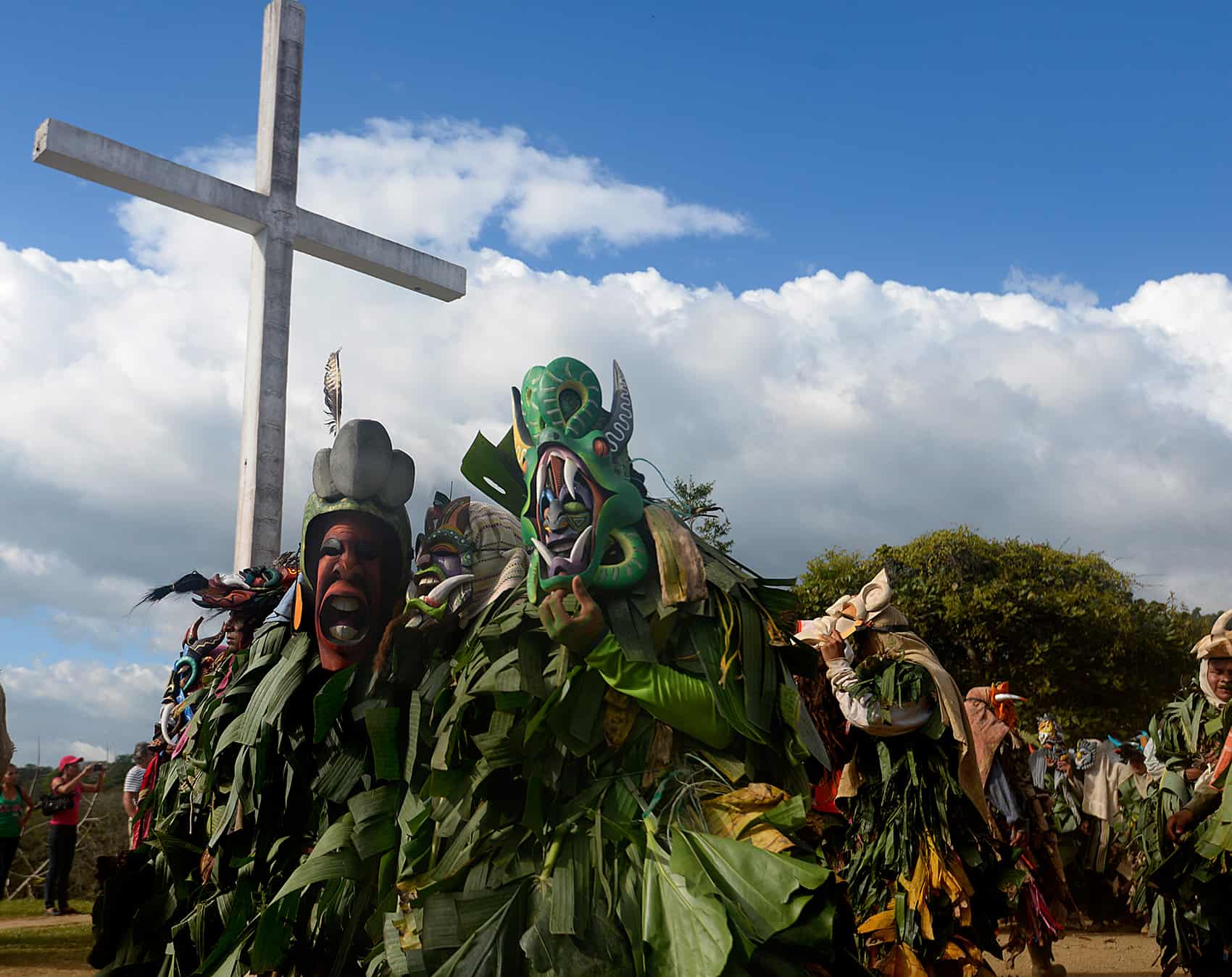The bull wagged its head side to side. Its feet dragged in the dirt. Men yelled and chanted. They jumped up and down. They thrust their pelvises. They danced in circles, taunting the bull with their shrieks. They whipped at the bull with rubber hoses and colored tassels. Suddenly the bull launched forward.
It slammed its head into a mustached man and pushed him backward. At first I thought the high bushes would stop them, but the man crashed through the shrubbery, somersaulting off a muddy ledge. His body thumped hard as he hit the bottom of a drainage ditch, his limbs flailing all around. More men ran to him, grabbing his wrists and pulling him to his feet.
Wow, I thought. This is a lot more intense than I thought.
The “bull” was not an actual bull, but a body-puppet made of burlap sheets. It didn’t look like a bovine animal so much as a boxy tent, but the wooden mask of a bull was affixed to the front, and a makeshift tail wagged in the back. Every few minutes, the man inside the abstract bull would tip the contraption over and climb out, and another man would replace him. Then began a new round of gibing and charging.
As the bull whirled in random directions, the crowd of spectators backed away. The bull might charge at anyone; no one was exempt.
My wife Kylan stood nearby, her brow furrowed. She turned to our guide, Pedro Rojas. “Is that normal?” she whispered.
“Oh, yes,” said Pedro.
Kylan leaned toward me. “Maybe watch your camera. This looks like it can get pretty rough.”
This was the Juego de los Diablitos, or Little Devils’ Game, a communal ritual that takes place each year in the Boruca Indigenous Reserve. For 400 years, the Brunca people have donned masks and constructed their bull. Their strange combat is more than mere horseplay; the bull represents the Spanish conquistadors, who arrived in the 16th century with swords, muskets, and a mission to enslave anyone they found in the unmapped rainforest. The masked men represent the Brunca people, fighting back against the invaders.
After long minutes of roughhousing, two of the men lifted conch shells to their lips and blew long and hard. Slowly, the combatants stepped away from the bull, lifting their masks like football helmets and wiping their brows. They sauntered away from the grassy yard, entering the main road, where they ambled toward the next battlefield. Over the course of the day, the group would visit nearly every household in the village.
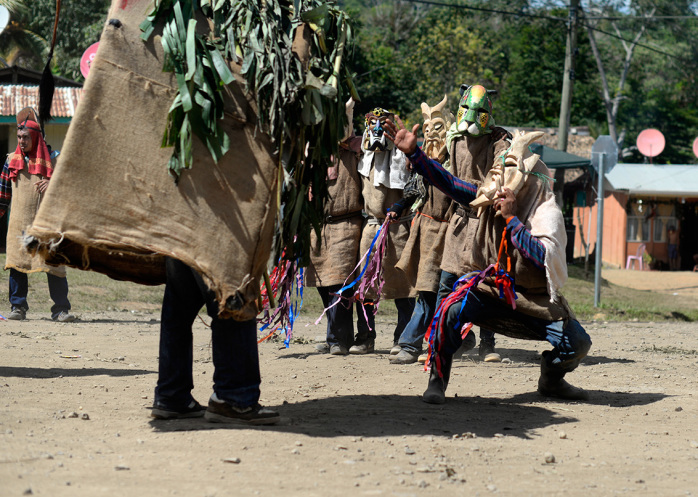
I first saw a Brunca mask in an Alajuela gift shop called Verdes y Colores. The mask was shaped like a devil, and its twisted fangs and horns were so monstrous that I actually laughed aloud. Its mouth snarled and a tongue lobbed out. I didn’t realize that the mask was carved out of a single piece of balsa or cedar, then meticulously painted in vibrant colors. It never occurred to me that someone might actually wear the mask.
“The Brunca wore the masks to scare off the Spaniards,” said the store’s clerk, María, who has since become a good friend. “The Spanish were Catholic, and the masks looked like devils, so they were afraid to fight.”
I smirked at this. Silly, superstitious conquistadors, I thought.
After that day, I saw Brunca masks everywhere. Scores of them hung in souvenir shops at Juan Santamaría Airport. Dozens more covered the walls of commercial galleries in downtown San José. With closer inspection, my appreciation grew. The masks were startlingly imaginative and detailed; some represented a single jaguar or monkey, but others showed toucans in trees, eyes peering through foliage, waterfalls pouring past humanoid mouths. They were not merely faces, but three-dimensional landscape portraits, a mix of tropical scenery and beastly visage. I had never seen anything like it before.
I started to give Brunca masks as Christmas gifts, because I admired the craftsmanship and I knew that each mask was unique. But I wanted to see where these masks came from. I had heard about the Juego, and I had a vague notion what the ritual looked like. The Culture Ministry dispatches dozens of press releases every December in the hopes that the media will attend the event. I had seen the overexposed digital photos that the ministry had sent, showing disheveled men in costumes. But what was it really like to be there? I had to see it for myself.
Luckily, I wasn’t alone.
“I’ve always wanted to see it,” said my friend Lindsay, a fellow writer for The Tico Times. “I miss it every time, and I really want to go this year.”
Kylan and I decided to make a road trip out of it, and Lindsay offered to chauffeur, since her car is equipped with four-wheel drive. For a San José resident, Boruca is fairly far afield. You can’t just hop a bus from the Coca-Cola bus terminal, nor is there a standard shuttle service. To reach Boruca, a traveler must drive through the mountains of central Costa Rica, rising to ear-popping elevations, then descend the hair-raising curves of the Pan-American Highway. The scenery is spectacular: Mythic ranges scroll past the windows, along with valleys draped in clouds. As we drove, the road leveled out past San Isidro, and the rainforest was subsumed in darkness. When we turned off the two-lane highway, we bumbled along a dirt road, losing ourselves in the dark hills. The road became rockier, more potholed. Lindsay’s Tracker jostled its way through the night, until we descended into Boruca’s valley.
We met Pedro at the central church, where a 10-meter cross rose from the gravel parking lot into the navy blue sky. Scattered lights ringed the vale. We could barely make out the wooded hills that surrounded us. Pedro arrived on foot, a big man with bright eyes.
“Buenas noches,” said Pedro in a soft bass. “¡Bienvenidos a Boruca!”
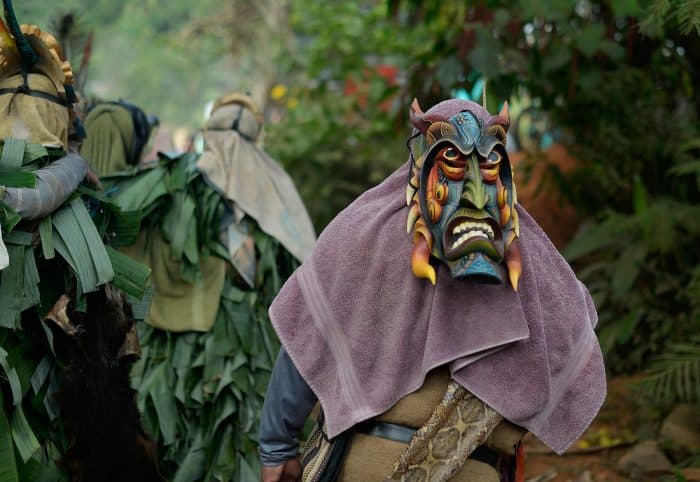
I had no idea what to expect in the “Boruca Indigenous Reserve,” an official title that didn’t conjure any images. Centuries ago, the Brunca lived in conical huts, whose thatched roofs reached to the ground. Without pictures or descriptions, I resorted to this pre-Columbian portrait: pigs hanging from spits, caciques wearing gold plates in their ears, and massive stone spheres standing in the grass. These were the images I had gathered from dioramas in the Jade Museum and Gold Museum in San José. The last time anyone had lived like this, Cervantes was still writing Don Quixote.
When we stepped out of our cozy cabina, I was surprised how the village appeared in morning light: Stout concrete cottages stood in rows on the sloped dirt roads. Nearly all the houses were single-story and small, but they seemed well-constructed and cared for. A chorus of roosters had called all night, and they continued to vocalize long after dawn. Pedro led us past a modern pulpería stocked with regular groceries. Painted wooden signs advertised rugged souvenir shops. We arrived at a small soda and sat at a plastic table in the front yard. The village was a maze of roads that went in all directions, snaking up hills and dropping into forest, but in general Boruca looked like almost any other small town in Costa Rica.
As we gobbled our gallo pinto and tamales, Pedro folded his hands on the table. “Do you have any questions?” he asked.
“First off,” I said, “I’ve always been curious: Are the people called the Boruca, or the Brunca?”
Pedro took a deep breath and looked upward. He did this every time we asked a question, as if preparing the perfect response. At last he murmured, “The people are called the Brunca, but this reserve is called Boruca.”
I sighed contentedly. For more than a year, I had heard various people—mostly white, mostly from the United States—bicker about what the Brunca call themselves. A few letters might not matter to most people, but I wanted to know for sure. We all know that European colonists spent centuries misnaming the indigenous people of the Americas. Using the right name, even the butchered, Romanized version of the right name, feels significant. Saying “Lakota” instead of “Sioux” will never bring back the dead of Wounded Knee, but it’s a shot at common decency.
But vocabulary is also a touchy subject, because the Brunca language is critically endangered. As Pedro explained it, only a handful of elders remember the ancestral tongue, and when they die, so too will their idiom. Unlike the Mayan languages of Guatemala or the Guarani languages of the Amazon, which are still spoken by thousands of everyday people, Brunca may have no future. While bilingual signs are posted around the shops, showing phrases in Brunca and Spanish, these are only novelties. There are no libraries full of Brunca-language books or a radio station broadcasting Brunca-language conversation. Like hundreds of languages around the world, Brunca teeters on the brink of extinction.
Lindsay and I tag-teamed Pedro with questions. After each query, he paused, considered fully, and then spoke in a slow, uninterrupted monologue for up to 10 minutes. He said about 2,500 people lived in the village, more than we had expected. (According to some sources, only 2,000 Brunca exist at all, including both the Boruca reserve and its sister community, Rey Curré.) Pedro listed the crops that area farmers grew—mostly beans, corn, and coffee, among other tropical staples. Pedro himself has lived in this village his entire life, working mostly as a car mechanic.
Our last coffee slurped, we followed Pedro around the corner to a small workshop. Inside, a craftsman sat in a chair and nodded to us. In his lap he cradled a wooden mask, half-carved, which he was patiently sculpting with a chisel. The mask was not yet painted, but the facial features were already clear.
I watched, reverent, as the man whittled. He leaned over his work, concentrating on the curls of wood that floated to the floor. This was exactly what I had hoped to see. It looked so normal, here in Boruca, to see a man shaping a block of wood into a sacred mask. As Lindsay snapped photos, I peered outside at a commons area, where a dozen Brunca sat on benches and steps. Women braided each other’s hair. The children and mothers sat snugly together, gazing in all directions. No one stirred. This little patch of ground, wedged between some squat buildings, might as well have been their living room.
“Look at them,” whispered Kylan. “It really looks like a community.”
This was the difference between my small hometown in Vermont, which has even fewer people than Boruca, and an indigenous village: Where Vermonters are private people, giving each other space, the Brunca are the last vestiges of an ethnic group, and they have always clung to each other for survival. Despite Spanish conquest and Catholic conversion, the Brunca behave like one big family. For the rest of our stay, we saw people clustered intimately together. I didn’t want to generalize or presume. We were only visitors. But the closeness was palpable.
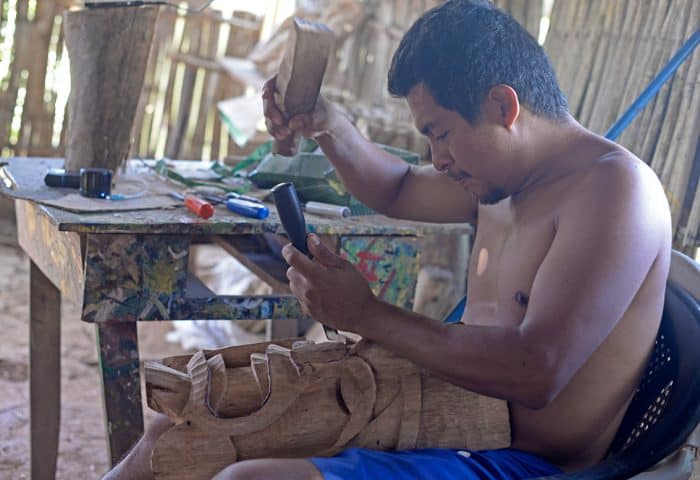
For hours, we followed the bull from house to house, and the battle continued. Drummers drummed, pipers blew shells, the masked men jeered and the bull charged. The fighting got rougher as we went; at one point, the bull slammed into a cluster of onlookers, pushing some of them off the hill. People vanished from sight, tumbling onto the roof of an adjacent building.
When we arrived at the central church, a man revealed a blue bucket and ladled clay-colored liquid into plastic cups. This was chicha, the corn-based beverage that the Juego was famous for serving. As Pedro explain it, chicha is not something you order at the corner bar. Chicha is a strong liquor and packed with calories. Throughout the three-day festival, participants drink chicha by the gallon, starting in the early morning and continuing until late at night. The drink makes them bold; they feel energized and impervious to the infernal heat. But chicha also makes them hopelessly drunk. Men staggered and crouched, overwhelmed by inebriation. Sometimes the man inside the bull costume simply fell over, and the others will help him up. Just watching them was exhausting.
“May I?” I asked the man with the bucket, and he poured chicha into my empty water bottle.
Lindsay took a swig, then Kylan, who handed the bottle to me. I gulped down liquid, which had the consistency of cider. But the taste surprised me; I had expected something dry and mealy, but the chicha smelled and tasted of wine.
“It’s good,” said Kylan, nodding.
“Yeah,” I said.
I was relieved to hear this, because Kylan is picky about taste. I was also relieved to say it, because now I felt like I was participating. Sort of.
As the minutes crawled by, it dawned on me how rare this was: The Juego is not an entertainment. It is not performed for the sake of visitors. Nor is the Juego a sporting event, with points and referees. If anything, the Juego is like a full-contact church service, a symbolic ritual that represents the spirit of the people. Their stamina was impressive; they could continue to improvise skirmishes all day long. By early afternoon, many of the men wore Band-Aids and bandages. Forearms were scratched and some men were cross-eyed with drunkenness. But still they persisted, flinging themselves at the cloth animal, because that is what tradition demanded.
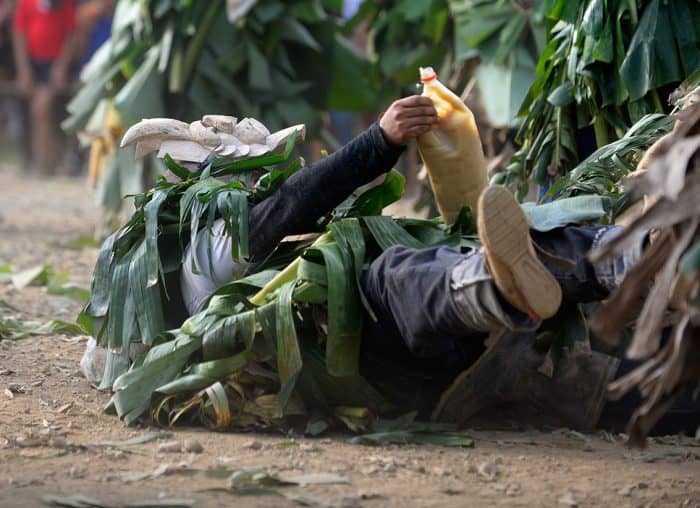
The shadows were lengthening when I turned a corner and saw them: A long procession of figures, dressed in togas made of leaves, their faces covered in demonic masks. Scores of people marched down the road, arms linked over shoulders, forming ranks of beastly warriors. Each mask was more elaborate than the last, each costume more impressive; eyes blazed, beaks jutted, noses flared, and real bird feathers blossomed around the wooden frame. Walking hip-to-hip, the leaf-covered men looked like walls of ivy advancing through the clouds of dust. Their numbers flowed through the village, arriving at last in a brown field. Hundreds of people surrounded the lawn, which had been roped off at the edges. Students and tourists had appeared for the first time that day, snapping pictures and staring in wonder. The tiny procession had accumulated hordes of Brunca and guests, because this was the festival’s finale: a massive melee involving all the diablitos at once. Then the diablitos would stop, cover the bull with kindling, and set it on fire. The ritual was to end in a blaze of glory.
Throngs of warriors surrounded the bull as it whirled and feinted, attacked and collapsed. The diablitos swirled around and around, phalanxes of men linking arms. When the bull tackled them, some men went down in piles of limbs, hitting their heads on the ground. The setting sun bled through their silhouettes, the yellow haze subsumed them, and the diablitos looked more fearsome and defiant than ever. The Spanish had not been superstitious, after all; the masks were terrifying to behold, but also powerful, dignified. It was as if the vegetation itself had come alive, a sentient forest rearing against its trespassers. I would never see those masks the same way again. They weren’t just art objects or funny costumes. The masks had purpose, here. They expressed the raging pride that human faces could not. They seemed, for the first time, alive.
